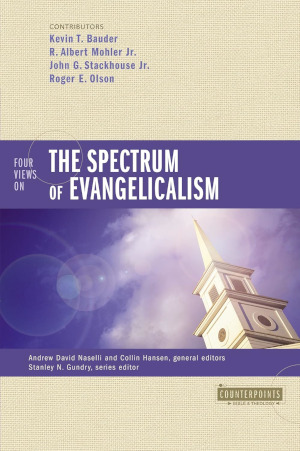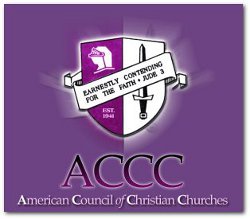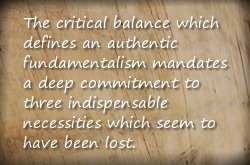Evangelical Spectrum: Four Views or Two Views?

Purchases help fund SI.
Just when readers think that the evangelical “four views” genre has covered every possible angle, editors Andy Naselli and Collin Hansen have come up with a book that explores evangelicalism itself. Zondervan’s Four Views on the Spectrum of Evangelicalism succeeds in presenting four engaging essays that describe the range of positions within evangelical thought. But the book leaves readers with a question. Are there really four views, or can they be boiled down to two?
More specifically, are we headed toward a convergence between mainstream fundamentalists and conservative evangelicals?
Sorting out the positions
Kevin Bauder presents mainstream fundamentalism as an idea worth saving, but not a movement worth saving. While many readers within fundamentalism are familiar with his views, the other three authors seemed somewhat surprised by his measured tone and his willingness to critique his own movement. Bauder contrasts his position with hyper-fundamentalism and populist revivalism, which he identifies as “deficient forms of the movement.” Bauder even worries that these two forces are now more prevalent in fundamentalism, with his own position losing influence. But for those who think that mainstream fundamentalism is identical to conservative evangelicalism, Bauder clearly states that it is not. For Bauder, there are still doctrinal differences related to the definition of the gospel, and practical differences related to separation. (Kevin Bauder’s chapter is excerpted as “Defending the Idea of Fundamentalism” in the November/December Baptist Bulletin.)
Al Mohler chose the term confessional evangelicalism to describe his own position in order to emphasize evangelicalism’s doctrinal center. He could have chosen the more popular title “conservative evangelicalism” (and in conversation he acknowledges they refer to the same movement), but the word “conservative” carries its own political baggage. Unlike the two authors who follow him in the book, Mohler wants an evangelicalism with clear, gospel-defined boundaries. His “first level theological issues” sound a lot like “fundamentals,” which he confirmed to me in a later Baptist Bulletin interview. For that matter, Kevin Bauder also affirms that they are talking about the same essential doctrines. But the difference between their two positions remains a matter of discussion.
Discussion
"I'll Never Change (my Doctrinal Beliefs)"
Is this how we are to approach the matters of fide and praxis?
What is right with it? What is wrong with it?
Discussion
Resolutions on Fundamentalism, Part 2
 The ACCC adopted four resolutions on fundamentalism at this year’s conference. The Resolution on Instances of Abuse wihin Professed Fundamentalism posted here earlier this week. Two of the remaining resolutions appear below.
The ACCC adopted four resolutions on fundamentalism at this year’s conference. The Resolution on Instances of Abuse wihin Professed Fundamentalism posted here earlier this week. Two of the remaining resolutions appear below.
Resolution on Cherishing the Heritage of Biblical Fundamentalism
Resolution 11-01
When exhorting his readers to patient endurance of the race set before them, the author of Hebrews affirms the importance both of looking ahead and of looking back. Looking ahead the believer must depend upon the person and work of Jesus Christ, the Author and the Finisher of our faith, and looking back he must draw encouragement and inspiration from a cloud of witnesses that once preceded and now encompasses him (Heb. 12:1-2).
The faithful men and women of Hebrews 11 comprise this cloud of witnesses: Abel, Enoch, Noah, Abraham and the patriarchs, Moses, Rahab, and others. Time would not allow the author to go on listing all the names (v. 32), so he summarizes their character by referring to their accomplishments (vv. 33-39). They were fallible servants of the Lord, but that is not the focus of this passage. Instead, an abundance of past-tense verbs expresses the affluence of the author’s appreciation for these true heroes of the faith.
This appreciation for the past enjoins us in the present to a similar faithfulness, for the author explains that, apart from us, the work of predecessors cannot be perfected (v. 40). We follow in their train. In addition, the appreciation for the past expressed in Hebrews extends not only to distant Biblical history, but also to more immediate examples, the pattern of those who spoke the Word to us (13:7-8). We are to remember with thankfulness their leadership, value the results of their ministry, and imitate their faith. Cherishing the heritage they provided for us reflects the immutable character of the Lord we serve, Jesus Christ, who is the same yesterday, today, and forever, and it safeguards against the temptations of varied and strange teachings (vv. 8-9).
Discussion
Measuring (and defining) Evangelicalism (and Fundamentalism)
Discussion
Resolution on Instances of Abuse within Professed Fundamentalism
 Resolution 11-06
Resolution 11-06
The corruption of Christian movements and organizations is a danger illustrated throughout the history of Christ’s Church. The record of heresies, scandals, greed, immorality, abuse, egomania and multiple other sins remind all to “be sober, be vigilant; because your adversary the devil, as a roaring lion, walketh about, seeking whom he may devour” (I Peter 5:8).
Lest we who are separatists be guilty of “straining at a gnat” and “swallowing a camel” (Matt. 23:24), or of seeking to remove a mote from another’s eye when a beam blinds our own (Matt. 7:3-5), or lest we be guilty of closing our ears to distressed victims, and of affirming evil by silence, we acknowledge with grief, revulsion, and unmitigated denunciation abuse that has been revealed within some professedly fundamentalist churches and ministries.
For example, confirmed reports of severe corporal punishment cite an instance of beating and bruising children, the failure to report to authorities bruises found on children as a result of abuse in their homes, and a flaunting of corporal discipline, evidenced in such practices as giving a souvenir paddle to ministry visitors.
The same ministry context involving this shaming of children included humiliation before their peers and forcing them to wear garments of the opposite sex as a punishment for inappropriate performance. Such would doubtless be condemned as a wicked perversion if a child opted of his own volition to dress in this manner, yet for the purpose of shaming, this ministry demanded this conduct of children.
Discussion
Was Peter Too Holy?
Discussion
Moving Toward Authenticity: Musings on Fundamentalism, Part 2
 Dr. Doug MacLachlan presented this paper at Central Seminary’s fall conference on Oct. 17, 2011. Read part 1. Part two begins with the second of three indispensible necessities for authentic fundamentalism.
Dr. Doug MacLachlan presented this paper at Central Seminary’s fall conference on Oct. 17, 2011. Read part 1. Part two begins with the second of three indispensible necessities for authentic fundamentalism.
Discussion
"70% Evangelicals in the U.S. ... say they think of themselves first as Christians rather than as Americans."
Body
Discussion
Moving Toward Authenticity: Musings on Fundamentalism, Part 1
 Dr. Doug MacLachlan presented this paper at Central Seminary’s fall conference on Oct. 17, 2011. It will post here in two parts, today and tomorrow.
Dr. Doug MacLachlan presented this paper at Central Seminary’s fall conference on Oct. 17, 2011. It will post here in two parts, today and tomorrow.
My personal spiritual journey—it begins with a fundamental church.
The church is God’s good family in man’s broken world.
In 1 Timothy 3:15, Paul defines the church as: “the household (the family) of God.” In effect, Paul is saying to our 21st century body of Christ: “Be what you are:” The family of God in a world of fractured families; a home-base for the familially disenfranchised! A very significant part of our calling as 1st century Christians and churches in a 21st century world is to be a place where relational warmth, familial love, gospel truth, and biblical exposition can be found. If we fulfill this function biblically and compassionately we will impact our world rescuingly and redemptively for Jesus Christ.
I know this first from Scripture, but second from personal experience. My familial pedigree has never been considered very impressive. I am the son of a bartender, and the grandson of a gangster. My first encounter with “family” as it was ordained by God to be was in the context of a local, fundamental Baptist church in the small village of Montrose, MI where I was raised. I brought nothing of value or status to the small community of believers in Montrose Baptist Church, except my eternal soul as a creature made in God’s image, and as a sinner for whom Christ died. That was enough for that body of believers to welcome me into their midst and invite me into their homes.
Discussion